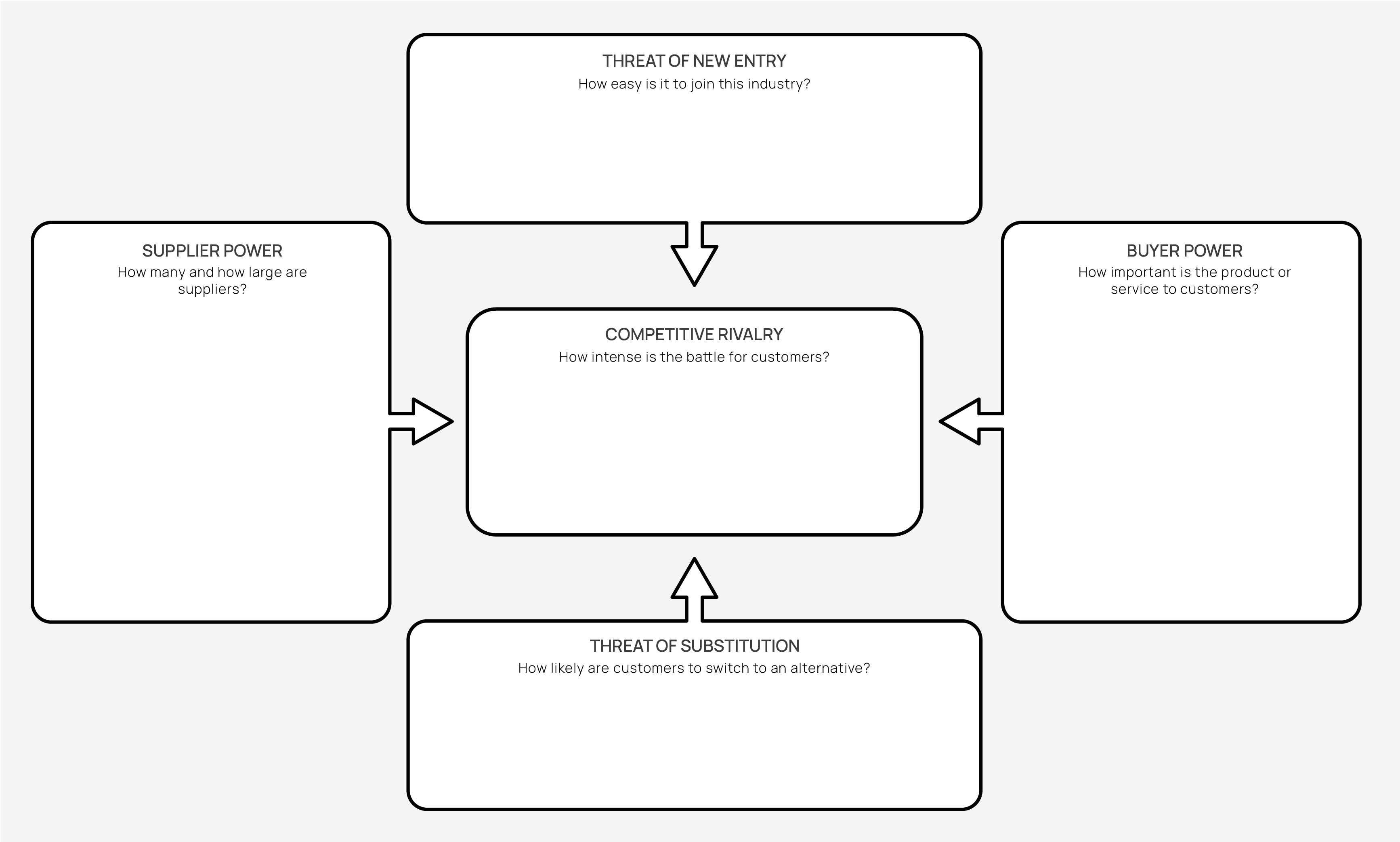Porters 5 Forces
Porter’s Five Forces is a tool that helps organisations see how much competition they face in an industry. It helps with figuring out if it’s a good idea to grow or start a venture in that industry.
The method involves analysing five key forces:
- Bargaining power of buyers: How much influence customers have in getting better deals from organisations in the industry
- Bargaining power of suppliers: How much control suppliers have over setting prices and terms with the organisations they supply within the industry
- Threat of new entrants: How likely it is that new organisations enter an industry and causing challenges for existing organisations
- Threat of substitutes (products or services): How likely it is that customers switch to similar alternatives offered by other organisations or industries
- Intensity of competitive rivalry: How fierce the competition is among existing organisations in the industry
Check out our video lesson here
The results
- Insights into whether the target industry is attractive overall
- Identification of industry risks
- Identification of industry opportunities

When to use it
Strategy formulation: Evaluating or making strategic decisions
Exploring new possibilities: Introducing a new product or venture
Strengths
Structured and comprehensive
Simple
Versatile
Widely recognised
Broadens strategic focus to external competition
Weaknesses
Dates quickly
Equally prioritises forces
Disregards internal factors
Oversimplifies the complex
How to use it?
What do I need to start?
Information relevant to the organisation or industry. For example:
- External insights such as market research, industry reports, and regulatory settings
- Internal insights such as information on costs, distribution channels, suppliers, and customer behaviour
How to use it?
Who to involve?
Porters 5 forces can benefit from different perspectives. Consider involving:
- People who can offer insights into suppliers such as relationship managers
- People who can assess the profitability and financial health of competitors, such as financial analysts
- People who can provide insights into customer preferences, buying behaviours, and competitive positioning, such as sales and marketing staff
Step by step
1
Identify and define an industry segment
Identify the focus industry segment. Defining the industry well is important, as this definition can change the results of the exercise.
For example, an organisation selling movie entertainment through physical locations (cinemas) might consider their industry to be the cinema industry. This narrow view could create blind spots. Customers might see alternatives not only as other physical entertainment options (like bowling) but also as different ways to consume movies (such as Netflix).
Consider asking the following questions to narrow in on a industry segment definition:
- What alternatives do our target customers consider instead of the product or service?
- How do organisations within the industry define the industry?
- How do similar organisations define their competition?
- What advancements or changes from outside the industry could disrupt it?
2
Work through each of the 5 forces
For each force:
- Cluster insights
- Identify where there might be knowledge gaps requiring more research
3
Bargaining power of buyers
To understand how much power customers have, ask questions like:
- How important is our product or service to our customers?
- Do customers have many choices?
- What strategies do our competitors use to attract and retain customers?
4
Bargaining power of suppliers
To understand supplier power, ask questions like:
- Are there many suppliers?
- How large are the suppliers?
- How dependent are we on our suppliers for key resources or materials?
- Can the business get product elsewhere easily?
5
Threat of new entrants
To assess the threat of new entrants, ask questions like:
- How easy is it to join this industry?
- Is a large capital investment required?
- Are there any regulations or government policies that restrict entry into our industry?
6
Threat of substitute products or services
To understand threat of substitution, consider alternatives customers might use to complete the same job as what the product or service does. These substitutes may not come from the same industry. Ask questions like:
- What alternative products or services exist that could fulfil the same need as ours?
- How high are the costs to change between providers?
- What does the #1 competitor do better than all the other competitors?
- ‘How difficult is it to differentiate between products?
7
Intensity of rivalry
To understand rivalry among existing competitors, ask questions like:
- How many competitors are there?
- How intense is the battle for customers in the industry?
- What is the level of price competition among existing competitors?
- Is the industry growing?
8
Analyse
Analyse all of the insights gathered. Ask questions like:
- What is the potential within the industry?
- Is entering the industry desirable and feasible?
- Is exiting the industry desirable and feasible?
- What action can be taken to strengthen the organisations position?
Consider what actions can be taken based on the insights. Consider using tools such as:
- Blue ocean strategy map
- Business Model Canvas
- Road mapping
- MOST (Mission, Objectives, Strategies, and Tactics)
- Hoshin Kanri method